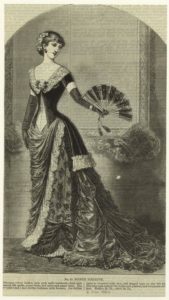 Who cares if Lady Claire, the daughter of the Duke of Rockland, marries Sir Ware, a baron? Her married name will be Lady Ware, and a lady is a lady, right?
Who cares if Lady Claire, the daughter of the Duke of Rockland, marries Sir Ware, a baron? Her married name will be Lady Ware, and a lady is a lady, right?
Not exactly.
I get a lot of questions about keeping all of those lords and ladies straight in historical romances and why titles matter. It's complicated in particular because although the peerage has clear rankings (a duke is higher than a marquess, etc.) some people are addressed the same way. This is especially confusing among women.
Here's a long but hopefully handy guide to telling your barons from your viscounts:
The Royals
Royalty includes the king and queen, the Prince of Wales, any children, and so on. Since I write about Victorian England, the reigning monarch would have been Queen Victoria. Prince Albert was her prince consort (the husband of the queen regent who was not a king himself). The Prince of Wales, the heir apparent, would have been Bertie who then became Edward VII on Victoria's death.
The Queen
The queen would first have been addressed as Your Majesty on first instance. Then she would be addressed as Ma'am.
Prince Consort, Princes and Princesses of Royal Blood, Dukes and Duchesses of Royal Blood
This group would have included Prince Albert, Victoria's husband who served as prince consort, the Prince of Wales, and all other royal princes, princesses, and royal dukes and duchesses. They would have been addressed first as Your Royal Highness and then afterward as Sir or Ma'am.

The Peerage
There are five hereditary titles for members of the peerage that are ranked as follows from highest to lowest: duke (duchess), marquess (marchioness), earl (countess), viscount (viscountess), and baron (baroness).
This might all seem straightforward, but it can become confusing and muddled for a few reasons. First of all, in addition to a title, a man or woman would also have a family name. For instance, I might be Julia Kelly, Marchioness of Dunnett. Kelly would be my family name, Dunnett would be my title.
Then there were courtesy titles. If a man was a marquess, he might be Christopher Kelly, Marquess of Dunnett, Earl of Kirk, and so on and so on. He would only be addressed as Lord Dunnett because marquess is his highest ranking title, and his eldest son would be given the courtesy title of Earl of Kirk and would be addressed as Lord Kirk. In the rare cases when there was no second title, the eldest son would be given the family name as a courtesy title (ie Lord Kelly).
There are even more exceptions to the rule, but for now let's focus on the most common instances.
Dukes and Duchesses
The name of a dukedom is taken from an existing place (ie the Duke of Devonshire). When addressing a duke or duchess, you would call them Your Grace (or referring to them in third person His Grace and Her Grace). My copy of Titles and Forms of Address recommends using titles sparingly in conversation.
The widowed wife of the last duke would would retain her title. However, to differentiate her from the current duchess she would be referred to as the Dowager Duchess and addressed by her first name and then her title. For example, after her husband died in 2004, the Duchess of Devonshire became the Dowager Duchess and was referred to as Deborah, Duchess of Devonshire.
The younger sons of dukes would be called Lord [First name Family name] and the daughters of dukes would be Lady [First name Family name]:
- Lord Colin Kelly (addressed in speech as Lord Colin, never Lord Kelly)
- Lady Justine Kelly (addressed in speech as Lady Justine, never Lady Kelly)
Marquesses and Marchionesses
Just to make matters complicated, the title of marquess can also be spelled marquis (they may choose how they spell it). The title is generally taken from a place name so one would be the marquess of [place name], although there are four modern exceptions to this rule just to keep things interesting.
A marquess and marchioness would be referred to as Lord and Lady Dunnnett and addressed in speech as My Lord and My Lady. The full formal title of the Marquess of Dunnett would only be used on very formal occasions.
Dowagers marchionesses follow the rule of dowager duchesses.
Younger sons of marquesses are Lord [First name Family name], and rules of address follow the younger sons of dukes.
Younger daughters of marquesses are Lady [First name Family name], and rules of address follow the daughters of dukes.
Earls and Countesses
Some earldoms take a geographical name (which would make the title the Earl of [Place]), some take a family name.
An earl and countess would be referred to as Lord and Lady [Title] and addressed in speech as My Lord and My Lady. As with marquesses and marchionesses their full formal title would only be used on rare formal occasions.
Dowagers countesses follow the rule of dowager duchesses.
Younger sons of marquesses are the Honorable [First name Family name], and would be addressed as Mr.
Younger daughters of earls are Lady [First name Family name], and rules of address follow the daughters of dukes.
Viscounts and Viscountesses
As with earls, the title is sometimes taken from a geographical name and sometimes a family name.
Titles and forms of address follow marquesses and earls, making them Lord and Lady [Title].
Dowagers viscountesses follow the rule of dowager duchesses.
Courtesy titles stop at the level of earls. The eldest son of a viscount is styled as the Honorable [First name Family name] as are the younger sons of viscounts. They would be addressed as Mr.
Younger daughters of earls are styled as the Honorable [First name Family name], and are addressed as Miss. The eldest daughter would be Miss [Last name] and her younger sisters would be Miss [First name] (ie Miss Emory would be the eldest sister followed by Miss Alexandra and Miss Alexis Emory).
Barons and Baronesses
Barons are the last rank of the peerage. Their names can be derived from geographical location, family name, or other sources.
Titles and forms of address follow marquesses, earls, and viscounts making them Lord and Lady [Title].
Dowagers viscountesses follow the rule of dowager duchesses.
The eldest son of an baron follows the form of address of the eldest son of a viscount. The younger sons of barons and the daughters of barons also follow the rule for viscounts.
If you're interested in learning more about forms of address, I recommend picking up a copy of Titles and Forms of Address.
I'm giving away two huge prize packs to celebrate the release of my book The Governess Was Wicked thanks to a little help from my author friends. You could win ebooks, signed paperbacks, audiobooks, and an Amazon gift card!. All you have to do is enter here:
a Rafflecopter giveaway




 Who cares if Lady Claire, the daughter of the Duke of Rockland, marries Sir Ware, a baron? Her married name will be Lady Ware, and a lady is a lady, right?
Who cares if Lady Claire, the daughter of the Duke of Rockland, marries Sir Ware, a baron? Her married name will be Lady Ware, and a lady is a lady, right?



